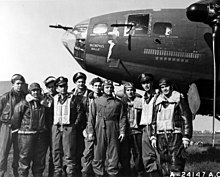George Petty

George Brown Petty IV(April 27, 1894 – July 21, 1975) was an Americanpin-upartist. His pin-up art appeared primarily inEsquireandFawcett Publications'sTruebut was also in calendars marketed byEsquire,TrueandRidgidTool Company. Petty'sEsquiregatefolds originated and popularized the magazine device ofcenterfoldspreads. Reproductions of his work, known as "Petty Girls," were widely rendered by military artists asnose artdecorating warplanes during theSecond World War,including theMemphis Belle.
Birth and early career
[edit]George Petty was born inAbbeville,the seat ofVermilion Parishin southLouisianato George Brown Petty III and his wife, Sarah. George, IV, was the couple's second child; his sister Elizabeth had been born in 1891. The Petty family moved toChicago,Illinois,just before the turn of the century, where George, III, a photographer of some note, enjoyed considerable success with images of young women, madonnas, and nudes.
Petty was not a particularly good student in high school, spending a great deal of time on extracurricular activities instead of schoolwork. His artistic bent first became obvious in high school, where he was the staff artist for the school newspaper.
During his high school years, he enrolled in evening classes atChicago Academy of Fine Artsunder the tutoring ofRuth VanSickle Ford,where he taught his own art course, charging classmates $5.00 per session. He also worked in his father's photo shop where he learned how to use anairbrush.In Paris, Petty studied art at theAcadémie JulianwithJean-Paul Laurensand others until 1916, whenWorld War IcausedMyron T. Herrick,ambassador at that time, to order all Americans to return home.
Petty returned to Chicago, and worked as an airbrush retoucher for a local printing company. He was able to establish himself as a freelance artist, paintingcalendar girlsand magazine covers forThe Household.By 1926, he was able to open his own studio.
Artistic influences
[edit]George Petty never discussed in detail those artists who influenced him, other thanJ. C. Leyendecker(an artist forThe Saturday Evening Postduring George's high school days) for his interpretation of men,Coles Phillipsfor his technique, andMaxfield Parrishfor his use of light. However, it can be inferred from his later work that other influences included artists who were extremely popular in Paris at the time, such asAlfons Mucha,George Barbierand, in particular, the watercolor technique of Britain'sWilliam Russell Flint.
"The Petty Girl"
[edit]Petty is especially known for "the Petty Girl", a series of pin-up paintings of women done forEsquirefrom its first issue in 1933[1]until 1956.[2]Petty frequently depicted these women with the relative lengths of their legs being longer—and the relative sizes of their heads being smaller—than those of his actual models.
George Petty used his daughter as the model for an optional hood ornament, "Flying Lady" available on the Nash automobiles in the early 1950s.[3]
Petty appeared as a guest on the popular TV programWhat's My Line?on November 20, 1955.
Petty died inSan Pedro,California,on July 21, 1975.
In popular culture
[edit]
- An image of a Petty Girl talking on a phone was used as the "nose art"on the famous World War II B-17 Flying Fortress,Memphis Belle.
- In 1959 a vector rendition of a Petty Girl derived from a 1956 Esquire calendar was displayed as part of the diagnostics for aSAGEair defense computer. This is claimed to be "earliest known figurativecomputer art".[4]
- Two images ofPetty Girlswere used in the crowd onThe Beatles'Sgt. Pepper's Lonely Hearts Club Bandalbum cover.
- Robert Cummingsportrayed George Petty in the imaginary musical comedyThe Petty Girl(Columbia, 1950), directed byHenry Levinand featuring the film debut ofTippi Hedrenas one of the Petty Girls.Nat Perrin's screenplay was based on a story byMary McCarthy.The film is also notable for several lilting, lighthearted songs composed byHarold Arlen(music) andJohnny Mercer(lyrics), including "Fancy Free" and "I Loves Ya". The large production number at the finale is "The Petty Girl" by Arlen and Mercer, performed byJoan Caulfield(dubbed by Carole Richards), the Petty Girls and a male quartet.
Sources
[edit]Reid Stewart Austin (The Best of Gil Elvgren) examined the life and art of George Petty in the 192-pagePetty: The Classic Pin-Up Art of George Petty.Published by Gramercy in 1997, the lavish volume features a foreword byHugh Hefnerand an introductory essay by Petty's daughter, Marjorie Petty, who was his main model. InThe New York Times Book Review,famed designerGeorge Loispraised this collection of Petty's creations, commenting:
Just as the cool, unapproachableGibson Girlwas the feminine ideal of young men at the turn of the century, the voluptuous Petty Girl became the ideal of their wide-eyed sons. I'm going on the record to swear that George Brown Petty IV consistently created better-designed women than God, and now I've got a big beautiful book to prove it.
References
[edit]- ^Petty, George (September 1, 1933)."Pardon Me, Miss, I Didn't See the Tennis Racket — I Thought You Had Forgotten Something".Esquire(1): 66.RetrievedJanuary 19,2023.
- ^"George Petty".The Pin-up Files.Archivedfrom the original on August 29, 2004.RetrievedDecember 16,2021.
- ^"Hood Ornaments for Nash and Related Cars".
- ^Edwards, Benj (January 24, 2013)."The Never-Before-Told Story of the World's First Computer Art (It's a Sexy Dame)".The Atlantic.Archivedfrom the original on February 17, 2013.RetrievedFebruary 16,2013.
